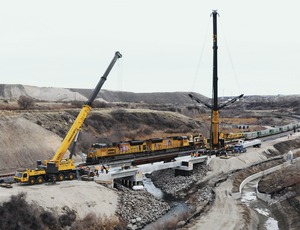
Construction firms working in the freight rail sector are benefitting from increased investment by U.S. railroad companies over the past decade. But freight infrastructure work is barreling ahead, thanks to a huge influx of capacity upgrade projects in the past 18 months to support oil and gas exploration, along with intermodal traffic increases, say industry experts.
The Association of American Railroads (AAR), an industry trade group, reports that in 2008, U.S. Class I railroads originated 9,500 carloads of crude oil. By 2012, that number jumped to nearly 234,000 carloads. In the first quarter of 2013, 97,135 rail carloads of crude oil were transported, a 166% increase from the same period in 2012.
While many of these carloads originate in fracking hotspots such as the Bakken Field in North Dakota and Montana, capacity upgrades are unfolding all over the U.S. "It's been an amazing boomlet in those places and a great opportunity for rail construction contractors to quickly build out new spurs, loop tracks and sidings," says Chuck Baker, president of the National Railroad Construction & Maintenance Association, a trade group representing rail contractors. While some of the work is located near the oil fields, other upgrades are being built at the refineries and chemical plants in the Gulf Coast, East Coast and elsewhere that are the oil's destinations, he adds.
In addition, oil industry supplies such as sand from Wisconsin and the Gulf Coast move primarily by rail to fracking sites. The pattern boosts specialized rail contractors such as New York City-based Railworks. "At this point we've done $50 million to $60 million of work in the Bakken area alone," says Jeffrey Levy, president and CEO. To kick-start its operations in North Dakota, Railworks rented a field from a local farmer and brought in temporary trailers for offices and living quarters.
Domino Effect
Designers are also getting in on the action. J.L. Patterson & Associates Inc., an Orange, Calif.-based engineering firm, has seen its Class 1 railroad design work jump from 15% to 35% of its total workload in just a few years.
"It's a domino effect, because the capacity is system-wide, not just in North Dakota," says Marc Cañas, vice president and COO. "Capacity needs will propagate into the Pacific Northwest, the Gulf and the south."
As a result, the nation's Class 1 railroads will spend $13 billion on capital expenditures to upgrade U.S. rail network capacity in 2013, according to the AAR. Competition mandates designing and building upgrades as quickly as possible.
Projects that once took 24 months to design, permit and construct are being squeezed into time frames as short as six to 12 months, Cañas says. "We are, by sheer need, innovating and coming up with ways to leverage technology to get a product out there that is going to meet the railroad and federal requirements for design standards, in record time," he adds.
Starting with GIS products and publicly available maps, engineers refine the data using their own surveyors and mappers, which enable them to start initial design much earlier, Cañas says.

